There’s something uniquely satisfying about making a great secondhand purchase. It’s a win for yourself, for the seller, and for the environment.

A major part of thrifting is the lure of the unknown, a hope and anticipation of finding just the thing you wanted and needed — or perhaps discovering that thing you didn’t know you wanted and needed. Whether the haul is purely practical or the stuff dreams are made of (a rather plainlooking vase purchased for $3.99 in a Virginia Goodwill store last year sold at auction for $107,100), shopping secondhand produces rewards that traditional retail shopping does not.
Thrifting is having a moment, to say the least. For proof, just drop by any resale outlet, especially on a Saturday or Sunday. Busy parking lots, crowded aisles, and long lines at the register tell the story of an increasingly popular way to shop — and one that is likely here to stay.
What’s old is new again — not just the clothes, housewares, and furniture in thrift stores — but thrifting itself is the new way to shop, both on-site and online.

After coming onto the retail scene just over a decade ago, “recommerce” online resale platforms like Poshmark and ThredUp are projected to grow 21% each year over the next five years, according to a recent report by ThredUp. The report also projects the overall U.S. secondhand market to more than double by 2026, reaching $82 billion.
The phenomenon is being driven by a perfect storm: With increased awareness about living more sustainably, there’s growing interest in upcycling, a rejection of fast fashion, and market responses to influential Gen Z buying trends. And with ongoing price hikes on everything from food to furniture, secondhand shopping is filling an important role in helping consumers stretch their dollars further.
“It’s hard for a young person to make a small salary or hourly wage, pay rent, crazy grocery prices, and be expected to pay $50-$100 for a pair of jeans at the mall,” said Kylie Lawhon, a Denver-based thrifting influencer and online reseller.
In Colorado and elsewhere, the COVID-19 pandemic also contributed to spur a surge in the resale market, with folks spending lockdown time cleaning out closets and flooding thrift stores with donations.
With ongoing price hikes on everything from food to furniture, secondhand shopping is filling an important role in helping consumers stretch their dollars further.
A STATE OF THRIFT
Colorado has long been a fertile state when it comes to thrift/resale/vintage/antique shopping options. A quick state records search of registered Colorado businesses with the word “thrift” in the name returned more than 250 results.

In 2022, Denver was ranked the number one city in the U.S. for thrifting by StorageCafe, based on analysis that included thrift store availability, sales volumes, and thrifting-related Google searches.
ThriftCon, promoted as the largest traveling vintage market in the world, was founded in Denver in 2019 and hosted its first events exclusively in Denver. In just five years, it’s become a wildly popular weekend destination, and this year will also hold conventions in Atlanta, Houston, and Portland.
“I think the state as a whole and the focus on sustainability makes Colorado a really rich state for thrifting opportunities,” said Ashley Furst, communications manager for Goodwill of Colorado. “People are conscious about what they’re buying and how they’re getting rid of things.”
Goodwill of Colorado, an iconic thrift store in communities statewide, opened in Colorado in 1918 and today operates 42 stores, four outlets, and one boutique shop. Last year alone, Goodwill received, recycled, or repurposed more than 248 million pounds of donated materials in Colorado. While one of its biggest stores sits on South Broadway in Denver, it also has successful operations in smaller communities including Canon City and Durango, with a new store opening in Falcon soon.
“When we identify a new area to expand to, we look at total population and demographics to support both donations and shoppers, and how many jobs we can create to expand our mission,” Furst said.
In southern Colorado, the town of Florence has been branded the antique capital of Colorado — a fitting title, since it’s home to more than 20 antique and vintage stores, according to Florence Chamber of Commerce President Joen Elliott. With a population of around 3,800, Elliott says the town relishes its artsy identity, which also boasts 15 restaurants with great food.
“It just seems to be kind of a mecca,” Elliott said, “It’s kind of a funky fun town. We’re real and raw and rural.”
The region draws people who have a deep-seated passion for antiques and vintage items. There are more than a few stories of people who have chosen to retire in Freemont County and opened antique shops in Florence. Elliott says the area has become a true destination spot, and it’s not uncommon to see visitors from Texas, Oklahoma, and Kansas.
A SMALL-TOWN ESSENTIAL
Along with offering wonderfully unique and nostalgic finds, thrift stores in smaller, more remote towns are a necessity. Secondhand shops in rural communities have long served as a place for locals to donate items that could be useful to others or when clearing out an estate. For shoppers, having a place to buy practical wares has been, and continues to be, not just convenient but needed.
“There’s not much out here — even a Walmart is a 40-minute drive — and we have clothing for the entire family, sports gear, kitchenware, and small furniture,” said Stacy Clodfelder, store manager of Retread Threads, a nonprofit thrift store in Haxtun.

The store opened a decade ago to support the mission of the Haxtun Methodist Church, with proceeds going to community members who need help with rent, food, medical care, scholarships, and transportation.
“It’s amazing to see how our little, tiny store can help so many people,” Clodfelder said.
The store gets regular donations from people in Fleming, Holyoke, and parts of Nebraska because, Clodfelder said, the next closest options are Sterling, Fort Morgan, and Greeley.
In the southern Colorado town of Del Norte, Sandra Aloisi recently opened Gently Loved Thrift Store in the town’s historic former hospital building, starting with inventory she’d gathered at yard sales for a few months.
“It’s a small town. We have a couple of antique places but no thrift store,” said Aloisi, who has lived in Del Norte for 12 years. “Walmart is 30 minutes away, and it’s nice having a variety of basic items here for people in our community, especially because we’re a low-income area.”
The store takes in donations every day and sells furniture, clothes, housewares, sports and camping gear, DVDs, books, tools, and more.
“I’ve loved thrifting for years — I come from a large family with 10 kids, and we’re all big thrifters,” Aloisi said. “I love being able to interact with people and focus on being real and personable with everyone who steps through our doors.”
Small-town thrift stores can serve as a familiar place to connect and catch up with friends old and new. Aloisi says she loves serving her community and seeing joy on the faces of lifelong Del Norte residents who stop in, excited to see new activity in the largely empty midcentury hospital where some of them were born.
One of Colorado’s oldest thrift stores may also be the most paradoxical. The Aspen Thrift Shop opened in 1949, and today its proceeds help fund more than $45,000 grants provided every month to more than 350 nonprofit organizations in the Roaring Fork Valley.
“We do a really great job of taking the money and giving it back to the community,” said Aspen Thrift Shop Board Member Cathy Moffroid. “The continuity of community and wanting to give back is sometimes surprising. There’s a real core of local community here.”

Moffroid says the added benefit of being in a resort community has helped support the shop’s success over the years.
“We have a section called The Boutique with designer clothes for men and women, and there are some real steals,” Moffroid said.
While the lure of finding a deal on an Aspen-caliber gem is a real possibility, Moffroid notes that the shop also fills an important need for resort workers.
“There’s a lot of young people who come into the valley to work seasonally, and they use the shop a great deal,” she said.
There’s not much out here — even a Walmart is a 40-minute drive — and we have clothing for the entire family, sports gear, kitchenware, and small furniture.” — Stacy Clodfelder, store manager of Retread Threads, a nonprofit thrift store in Haxtun
A FAMILIAR FUTURE
The momentum of the resale market is gaining speed, and even major retailers including Levi’s, REI, and Patagonia are now offering used clothing and gear for sale on their websites. Online recommerce shopping is expected to continue growing fast, at twice the rate of secondhand shopping overall, and artificial intelligence is already playing a role. Poshmark, for example, uses AI to assist in searches and product recognition. There’s a curious irony in futuristic technology driving the sale of vintage items created decades ago.
“It’s truly on-trend right now,” said Lawhon. “The aesthetic we see on social media platforms right now is vintage, worn-in styles. Modern stores are recreating distressed band tees, for example, but why not get the thrill of the hunt finding those tees for less than $5 at the thrift?”
Colorado’s diverse thrifting landscape truly offers something for everyone, from online sellers and social media influencers to brick-and-mortar stores both big and small. It’s the appeal of antiquing, the chance of discovering a rare piece of art, the gratification of finding a perfectly good toaster, baseball glove, or pair of jeans. It’s a space to contemplate what has been and what is to come — and the potential that lies in both.
“That is the joy of thrifting,” said Furst, “You never know what you’ll find.”
Mary Peck is a freelance writer based in northern Colorado and enjoys sharing stories of rural communities. She enjoys perusing secondhand stores of all varieties and spending the occasional afternoon thrifting with her Gen Z daughter.

clothes at Gently Loved Thrift Store in Del
Norte. Photo by Kylee Coleman.
AUGUST 17 IS NATIONAL THRIFT DAY Check out your local secondhand store — many celebrate with special offers and deals.
10 PRO TIPS FOR SHOPPING SECONDHAND
- Go early in the week for good selection — people often donate on weekends.
- Follow your favorite stores on social media to keep up to date, and tag them in your finds. They love to see what you post.
- Wear tight clothing (tank tops, leggings) so you can try on items over them if fitting rooms aren’t available.
- Carefully inspect items for damage before purchasing — but don’t be afraid to sew on a button for a fabulous vintage blouse.
- Wash what you buy. Check YouTube for tips on how to wash specific items such as shoes and hats.
- Know the store’s return policy.
- Go in with a plan. Save outfit ideas and home decor inspiration on a “To Thrift” Pinterest board.
- Only have time for a quick thrift? Scan the racks for colors and textures that pop out at you — you’ll find one-of-a-kind gems this way.
- Always thrift baby and kids’ clothing. Kids outgrow things so fast, so save the money where you can.
- Whatever you do — do not buy your basics new. Need a black tee? Thrift it. White button-down? Thrift it!
Thanks to Kylie Lawhon, a Denver-based thrifting influencer, online seller, and mom, for sharing these tips. Follow her on Instagram (@thatthriftedhabitat), Poshmark (@kylielawhon), and Whatnot (@kylielawhon).










